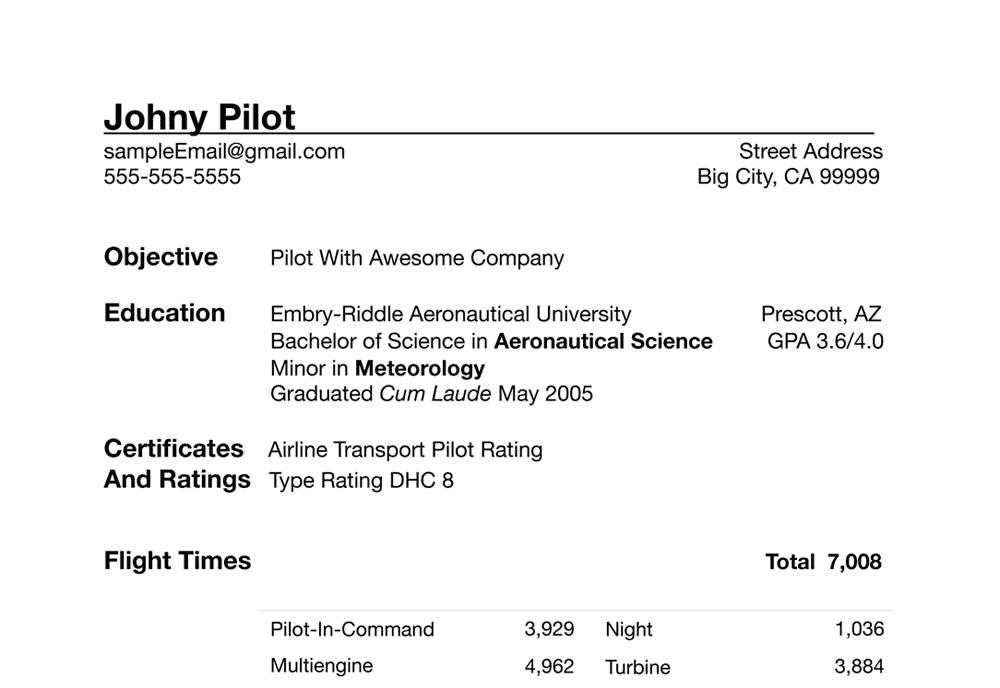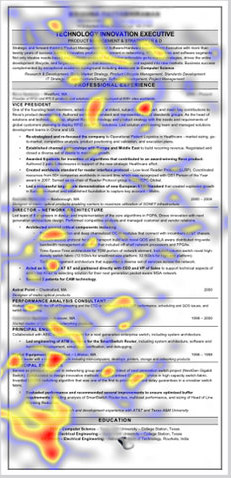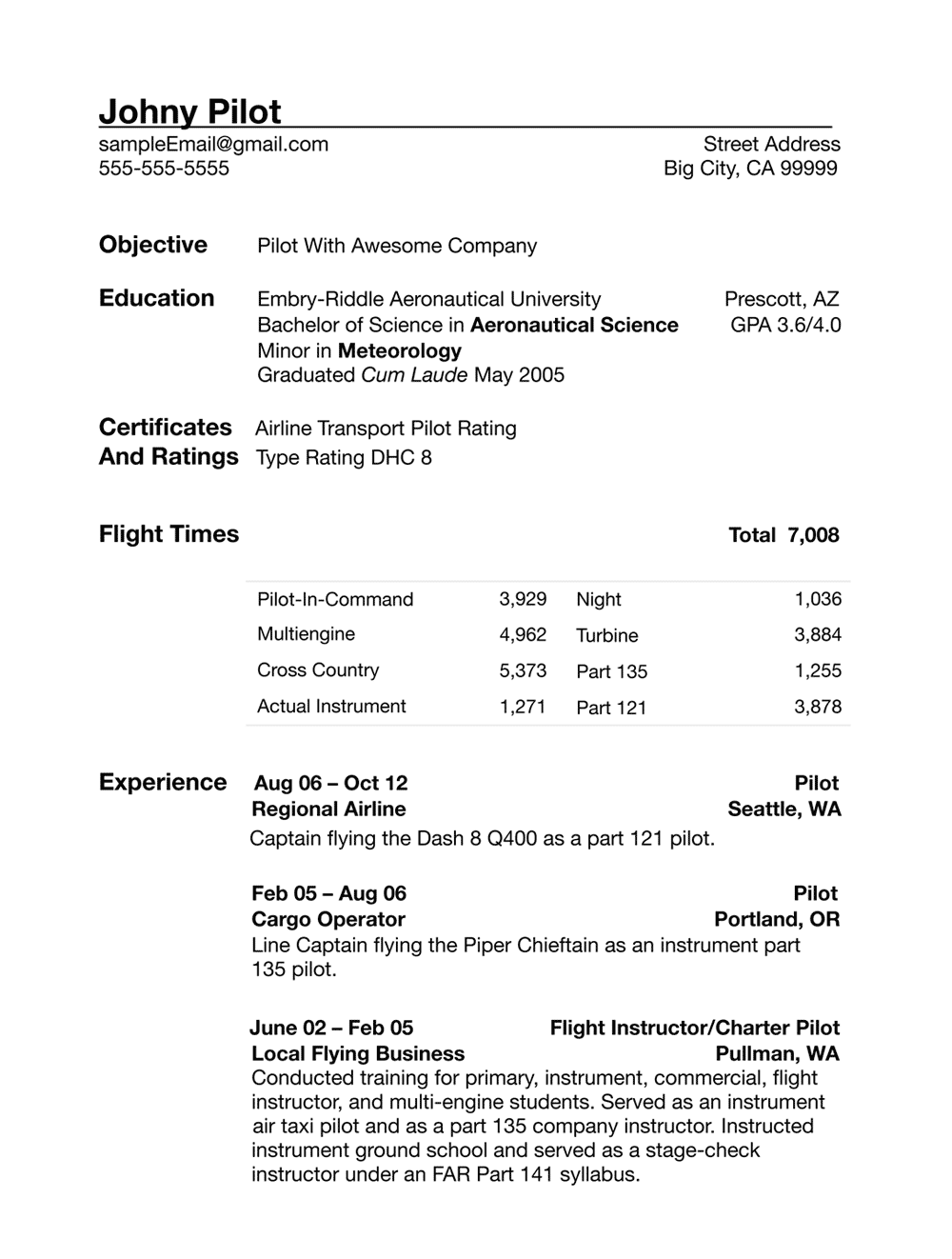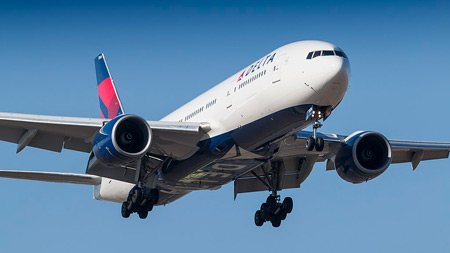Is Your Pilot Resume Sending the Right Message?

Creating a pilot resume is among the least desirable parts of a job search. But it is an important part of your search and is the initial key for getting in front of hiring managers.
A pilot resume should be a clear and concise document that a reviewer can easily scan to get an idea of your suitability for the position.
Make sure your resume is sending the right message about you.
Don’t Clutter Your Resume

A top mistake job seekers make is thinking ‘more is better’ when it comes to creating their resume. But when you put too much information on your resume it can hurt your chances:
- It makes you appear as desperate – that you are trying to hard.
- It becomes visually overwhelming causing readers to skip over most of it.
- Pilot resumes have standard conventions. Not following these conventions makes you appear either uneducated to them or unwilling to follow procedures.
Studies show that recruiters spend six seconds skimming a resume before deciding whether
to evaluate it more in depth. A long-winded resume is more difficult to skim and absorb.
What Hiring Managers See On Their Initial Scan
Eye tracking studies that showed hiring managers spend an average of six seconds scanning a resume also showed which sections they initially focus on:
- Your name
- Current title and company
- Current position start and end dates
- Previous title and company
- Previous position start and end dates
- Education
Resume studies haven’t included pilot resumes, which have different content and layout standard than traditional resumes. It is not known if pilot employers tend to focus more on pilot flight experience and qualifications on their
initial scan.
Creating a Standard Pilot Resume

You don’t want your resume to stand out because its format is different. You want your resume to stand out because of your qualifications and experience.
The purpose of a pilot resume is to provide a summary of your qualifications and experience. Your resume’s purpose is to list your qualifications so that you can then be further evaluated in an interview.
A pilot resume should be one page, and include the following information:
- Personal Information to include your name, address, phone number, email address, date of birth.
- Objective – state the position you are applying to and the company name. Make it appear that you aren’t just blasting a generic resume to several companies.
- Summary of your flight experience.
- Pilot qualifications to include the highest pilot certificates and ratings you hold and your medical certificates.
- Work history include past pilot positions or past positions related to the skills and experience a pilot should have. For each employer include name, duration of employment, the aircraft you flew, and your title.
- For education mention the degree you earned and the university you attended. Do not mention high school.
- Only list skills and achievements if room permits, and only list skills and achievements relevant to the position.
Flight Times That Are Easy to Scan
You can modify your flight time presentation to include whatever categories are appropriate for the job.
Make sure to include and highlight your experience as it relates to minimum experience required for the position. This way an employer can see at a quick glance that you meet the minimum qualifications for the position.
Highlighting Your Experience
The experience section is where you set yourself apart from other applicants and is where you detail what you’ve done and what you can bring to an employer.
Mention experiences a potential employer would find interesting. Only include items that have professional significance. If you’re low on aviation-specific experience include positions that require initiative and leadership.
Building Your Resume
For a recruiter, once they’ve reviewed their 500th resume they all start to look the same. Minor differences in flight time or flight training schools/universities attended go unnoticed after a while.
What catches a recruiters attention is responsibilities a pilot has above and beyond flying the line.
Recruiters begin to notice pilots that teach CRM, participate in recruiting or interviewing, develop training curriculum, serve as check airmen, sit on committees, and several other things that are often available to line pilots to pick up as additional responsibilities.
Always be on the look out for opportunities to advance your career beyond normal seniority progression.
If you have a position and a better one opens up don’t hesitate to jump at the opportunity. The new position may cause an interruption in your desired quality of life. But to really stand out you need to show you are always making moves to progress in your career.
What is your employer doesn’t have opportunities for additional responsibility? Approach them and mention how you would like to create new programs. Pretty much any program that improves safety, ensures regulatory compliance or decreases costs will work. Most employers will be receptive to ideas like this.
Not All Pilot Flight Experience is Equal

All flight time is good, but some flight time is better. Maintaining a progressing career requires continual evaluating what flight time is best for you right now.
When you have 1,000 hours in any time builder position, it’s time to start looking at stepping up to the next rung in the career ladder.
Ranking what flight time is most valuable can be difficult. But always ask yourself if you can be building more valuable flight time than the flight time you are currently building.
Remember that pilot employers like it when you take on more responsibility. Among the flight time most valued by pilot employers is time spent as a check airman or initial operating experience (IOE) instructor.
Ranking flight time value by aircraft type and seat position is a little more straightforward:
- Multi engine is better than single engine
- Crew operations are better than single pilot
- Turbine operations are better than piston
- Pilot in Command (PIC) is better than Second in Command (SIC)
- Pilot in Command (PIC) as an instructor pilot is better than just straight Pilot in Command (PIC)
The bigger, faster, and more complicated an airplane is the better. The primary benchmark to race for is 1,000 hours of multi-engine turbine pilot pilot in command time. When you reach this point many career doors open up.
Key Takeaways For Improving Your Pilot Resume
- Don’t pass up opportunities to build your resume beyond flight time. Take on additional duties and responsibilities when you can. If none are available, try creating them.
- Your resume needs to be clear, concise, and one page.
- Build a better resume through experience.
- Always check your resume contact information to verify that it is current.
- Build the highest quality flight experience as quickly as you can.
Greg started his professional pilot journey in 2002 after graduating from Embry Riddle. Since that time he has accumulated over 8,000 hours working as a pilot. Greg’s professional experience includes flight instructing, animal tracking, backcountry flying, forest firefighting, passenger charter, part 135 cargo, flying for a regional airline, a national low cost airline, a legacy airline, and also working as a manager in charge of Part 135 and Part 121 training programs.



